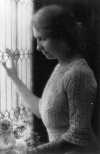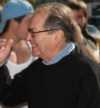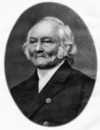 This festival in Tuscumbia, Alabama, honors Helen Keller and her remarkable life. Born in Tuscumbia in 1880, she was left blind, deaf, and mute by illness at the age of 19 months. Helen learned to read and write and later graduated cum laude from Radcliffe College. She became known for her writings and toured the world to promote opportunities for blind and deaf persons. Festival events include art exhibits, musical entertainment, a parade, and historic tours. At Miss Keller’s birthplace, Ivy Green, visitors can see the pump at which Helen learned her first word, “water.” Discuss
This festival in Tuscumbia, Alabama, honors Helen Keller and her remarkable life. Born in Tuscumbia in 1880, she was left blind, deaf, and mute by illness at the age of 19 months. Helen learned to read and write and later graduated cum laude from Radcliffe College. She became known for her writings and toured the world to promote opportunities for blind and deaf persons. Festival events include art exhibits, musical entertainment, a parade, and historic tours. At Miss Keller’s birthplace, Ivy Green, visitors can see the pump at which Helen learned her first word, “water.” Discuss
Source: The Free Dictionary
Evidence is mounting that doctors who receive as little as one meal from a drug company tend to prescribe more expensive, brand-name medications for common ailments than those who don’t. A study published online Monday by JAMA Internal Medicine found significant … Discuss
 After WWII, Korea was divided at the 38th parallel, with Soviet forces occupying the north and US forces occupying the south. Negotiations to reunify the two zones failed, and in 1950 the North invaded the South. US President Harry Truman ordered troops to assist South Korea, and the UN backed the mission. As UN troops advanced across North Korea, the People’s Republic of China intervened, pushing them back to the original boundary at the 38th parallel. How many people were killed in the war?
After WWII, Korea was divided at the 38th parallel, with Soviet forces occupying the north and US forces occupying the south. Negotiations to reunify the two zones failed, and in 1950 the North invaded the South. US President Harry Truman ordered troops to assist South Korea, and the UN backed the mission. As UN troops advanced across North Korea, the People’s Republic of China intervened, pushing them back to the original boundary at the 38th parallel. How many people were killed in the war?  This festival in Tuscumbia, Alabama, honors
This festival in Tuscumbia, Alabama, honors  Lumet was an American film and television director with over 50 films to his name, three of which received Academy Award nominations for Best Director. He began acting as a child, appearing in Yiddish productions and on Broadway. After serving in WWII, he began directing plays and teaching acting. He directed more than 200 television dramas before making his debut as a movie director in 1957 with the acclaimed Twelve Angry Men. For what did Lumet receive an Academy Award in 2005?
Lumet was an American film and television director with over 50 films to his name, three of which received Academy Award nominations for Best Director. He began acting as a child, appearing in Yiddish productions and on Broadway. After serving in WWII, he began directing plays and teaching acting. He directed more than 200 television dramas before making his debut as a movie director in 1957 with the acclaimed Twelve Angry Men. For what did Lumet receive an Academy Award in 2005?  Written and illustrated by Italian architect and industrial designer Luigi Serafini over a 30-month period from 1976 to 1978, Codex Seraphinianus is a visual encyclopedia of an unknown world. Each of the book’s 11 chapters uses an incomprehensible alphabetic language and colorful textbook-style illustrations to describe the world’s nature and various aspects of life, including its surreal animals, machines, and history. What chapter is thought to be the most abstract and enigmatic?
Written and illustrated by Italian architect and industrial designer Luigi Serafini over a 30-month period from 1976 to 1978, Codex Seraphinianus is a visual encyclopedia of an unknown world. Each of the book’s 11 chapters uses an incomprehensible alphabetic language and colorful textbook-style illustrations to describe the world’s nature and various aspects of life, including its surreal animals, machines, and history. What chapter is thought to be the most abstract and enigmatic?  Germany was the site of one of the first outbreaks of dancing mania, a phenomenon seen primarily in mainland Europe between the 14th and 17th centuries. During such outbreaks, groups of up to thousands of people would dance uncontrollably, screaming, shouting, and claiming to have visions until they collapsed from exhaustion. Initially considered a curse sent by a saint, usually St. John the Baptist, it was called “St. John’s Dance.” To what do researchers now attribute the strange behavior?
Germany was the site of one of the first outbreaks of dancing mania, a phenomenon seen primarily in mainland Europe between the 14th and 17th centuries. During such outbreaks, groups of up to thousands of people would dance uncontrollably, screaming, shouting, and claiming to have visions until they collapsed from exhaustion. Initially considered a curse sent by a saint, usually St. John the Baptist, it was called “St. John’s Dance.” To what do researchers now attribute the strange behavior?  The
The  Weber was a German physiologist who is known for his work on touch and for the formulation of Weber’s law—which states that the increase in stimulus necessary to produce an increase in sensation is not fixed but depends on the strength of the preceding stimulus. Weber’s law led to the discipline of psychophysics and serves as the basis of the scales used to measure the loudness of sounds. He is considered a founder of experimental psychology and is also known for what discoveries in anatomy?
Weber was a German physiologist who is known for his work on touch and for the formulation of Weber’s law—which states that the increase in stimulus necessary to produce an increase in sensation is not fixed but depends on the strength of the preceding stimulus. Weber’s law led to the discipline of psychophysics and serves as the basis of the scales used to measure the loudness of sounds. He is considered a founder of experimental psychology and is also known for what discoveries in anatomy?